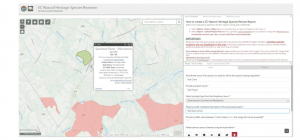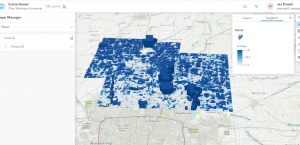Fox – Week 1
I did all of the other requirements and the ArcGIS stuff for this week back in GEOG 291!
Module 2: 10/13/2025 - 12/5/2025, OWU Environment & Sustainability
Hi I’m Lexi Stratton, and I’m a sophomore. I’m an Environmental science major and a French minor.
For this week I took the quiz, and signed up for the meetings. All the ArcGIS online stuff I did for GEOG 291.
Hello all, my name is Sophie. I am a sophomore in the environmental science program at the moment. I am from Pleasant City, Ohio, and I’m really passionate about developing various types of maps. I discovered this passion by taking the class Geog 291 earlier this semester. I also major in Zoology at Ohio Wesleyan University .I also partake in a number of other pursuits that keep me occupied and amused. I am a member of the Ohio Wesleyan University rugby team. I like to watch anime when I’m not playing. In addition, I compete with other gamers as a member of the esports team. Lastly, I enjoy riding my bike around campus because it allows me to stay active while taking in the stunning surroundings.
One of my interests that using ArcGIS Online may assist with is protecting wildlife. There are many ways that using ArcGIS Online can help via conservation efforts in this field. For example, it can be used to follow animals, which helps scientists learn more about how they move and act over time. It also helps keep track of species inventories, which are essential for keeping an eye on population changes and checking on the health of different species. ArcGIS Online can also be very helpful for numerous studies because it has tools for visualizing and analyzing data. Lastly, it lets scientists and conservationists map biodiversity, which helps them learn more about where different ecosystems are located around the world.

ArcGIS Online is by having workers use their GIS skills to keep track of and arrange cultural and natural assets. Technology is crucial for preserving such assets at every stage of leisure development and maintenance. GIS can help find sensitive areas that need extra care before growth can happen. To protect these assets, employees can keep an eye on operations while the building is going on. Even after the recreational projects are finished, GIS is still essential because it provides tools for managing and preserving biodiversity and cultural assets over the long term. In this way, GIS ensures the preservation of cultural and environmental resources while also assisting in the process of making well-informed decisions.

Final Two Apps
For the app based on Chapters 1-4 I created a survey that took a look at the various right of way points in neighborhoods in Delaware. I think this survey could be used to see which areas in Delaware require thing put in place to make a right of way stop easier to navigate such as better crosswalk line visibility.
For the app based on Chapters 5-7 I created a simple web scene of the various acres of land in Delaware using the Parcel data from the Delaware Data. This 3D map just shows which parcels have a bigger acreage.

Chapter 7
Chapter 7 looked at 3D web scenes and other basic 3D elements of GIS along with some mentions of VR. I found this week to be pretty easy to follow through as in the previous section of this class we took this semester we had done a little bit of 3D work in ARCGIS pro. I really enjoyed creating a web since using feature layers and 3D object symbols and found it overall to be pretty cool. Creating the layout of the park reminded me a lot of the sims which was fun. I feel like this chapter was very similar and familiar to something we had done in GEOG 291 and I found this overall to be very easy to go over.
Final two applications
1.For my first application I was inspired by the chapter 4 tutorial on Survey123. As I’ve walked around campus, I have noticed that wildlife is abundant in this area. This made me want to create a survey where users could select the wildlife they spotted and put the exact location where it was seen. Users could also select the date it was spotted and even add pictures with their response. This would allow for easier reporting of animals and understanding where they frequent the most. This could be helpful for people who may want to avoid areas with skunks or areas where deer populations are higher, prompting more caution when driving.
https://arcg.is/0zSuzO
2.
This first application leads me into the second, where I’m applying the data from the survey and making it easier for the public to view. Rather than just keeping data for myself, I wanted to create an interface where people could see the real-time data. I used information from chapter 6 tutorials to create a comprehensive dashboard that uses data from my Wildlife Reporting survey. I created data from the survey into a feature layer by making it into a map scene. I then opened up a dashboard and almost exactly followed the tutorials from the book. I ran into a few problems but was able to move past them, creating an informative dashboard. The dashboard includes a gauge to show the number of wild animal sightings in the last 10 days, the 10 most recent sightings and what they were, the frequency of what animals have been spotted over the last month, and also a map with pinpoints of exactly locations. The survey and the dashboard will be published so that everyone can collaborate on it whether or not they’re in our organization.
https://owugis.maps.arcgis.com/home/item.html?id=9a3aaab2f19843edbca04647a2da2220
Data used:
Topographic map of Delaware County from ArcOnline
“Fake” data from the Survey in order to show how the dashboard would look/function
For my final project, I used ArcGIS to look at how easy it is for people in Delaware County, Ohio to get to a public park. I wanted to find out how many houses are close enough to a park to walk there, using a half-mile distance. I used data from the Delaware County GIS website and tools from Chapters 1 to 4 to do this.
Data I Used:
Steps I Took and Tools I Used:
What I Found Out: I found that a lot of homes in central and southern Delaware County are within walking distance to a park. But some of the rural areas up north don’t have as many nearby parks. This could be helpful for planning where new parks should go.
Conclusion: This project helped me understand how GIS can be used to solve real-world problems. By using buffers, joins, and queries, I was able to find out who has access to parks in the county. In the future, it would be cool to add more info like population or public transport to see how that changes the results.
Building upon the insights gained from Chapters 5–7 , I developed the Delaware Environmental Justice Explorer, an application designed to identify and visualize areas in Delaware where environmental burdens intersect with vulnerable populations. This tool aims to assist policymakers, researchers, and community members in understanding and addressing environmental justice concerns within the state.
A policymaker interested in addressing environmental justice can use this application to identify communities in Delaware that are disproportionately affected by environmental hazards. By analyzing the overlap between pollution sources and socioeconomic data, the policymaker can prioritize areas for intervention and allocate resources effectively.
This week It focused on using smart mapping and how to make your web maps more interactive and useful. I learned how you can use different styles and settings to better show your data, like changing symbols based on a number field, using color ramps, and adjusting pop-ups so they show only what you need.
One thing I liked about this chapter was how easy it made the maps look once you knew what tools to use. It showed me how much better a map looks when you adjust the symbology and make it more visual for the user. I also liked learning how to make pop-ups cleaner and more helpful so people only see the important info.
One thing I found tricky was deciding which type of symbol or color ramp to use. Sometimes it looked cluttered if I picked the wrong one. I also had to play around with the labels to make sure they didn’t overlap.
For my application, I used the Delaware County data from Geog 291 to create a smart map that shows where public parks are and how many houses are nearby each park. I made the parks stand out by symbolizing them based on the number of homes within a half-mile. I used different shades of green; darker green meant more nearby homes. I also changed the pop-ups so they only showed the park name and number of houses close by. This map could help city planners see which parks are busy and where new ones might be needed.